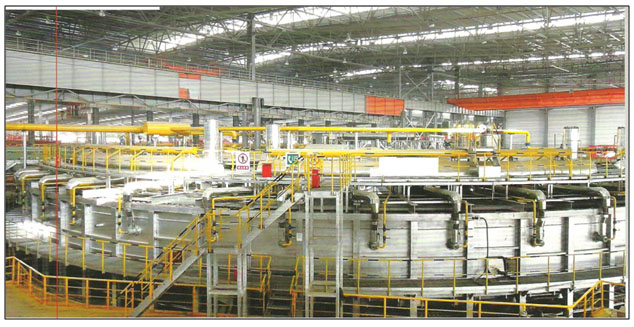Carbon-composite briquetting of iron ore fines & fast-reduction into DRI in the rotary hearth furnace
GoodRich offers the technology for carbon-composite briquetting & subsequent reduction of iron ore into DRI in the rotary hearth furnace from a reputed manufacturer in China, in capacities from 70,000 tons to 320,000 tons per year.

Iron-carbon composite is produced by mixing iron ore fines & anthracite coal fines, and densified by briquetting. These briquettes are dried & finally reduced in the rotary hearth furnace in 30-40 minutes. As the carbon particles directly touch the oxygen particles & high temperatures of 1,250-1,350°C are maintained in the process, the reduction is much faster. Hot DRI briquettes can be directly charged into the Electric arc furnace / Gas Oxygen Refiner (GOR) to make steel.
It is desirable to use high-grades of iron ore (60-65% Fe grades) and anthracite coal (75-80% fixed carbon & 10 – 15% ash) in the process. Rotary hearth furnace was originally developed in Japan. Many such plants are running successfully in China now.
This third generation iron making technology uses cold-bonded self-reducing briquettes made fromthe iron bearing residues (such as blast furnace dust) plus fines of pet coke / anthracite coal / charcoal or any other carbon-bearing residues. These materials are mixed with the binding agents, agglomerated& cured in a drier, producing briquettes that have sufficient strength for the physical & metallurgical demands of the process. This self-reducing short process of iron making is highly energy-efficient & environmentally desirable, as it ensures effective use of iron ore & coal resources.
In the carbon-composite briquettes, the distance between iron ore & carbon is shortened, so that the reduction of iron ore & the gasification of carbon occur rapidly at the same place. CO2 produced from the reduction is used for the gasification to generate CO simultaneously. Burners provide the initial heat required to raise the briquettes to reduction temperature & to start the process. These burners are fired with fuel oil, pulverized coal or coal gas. Most of the heat required for maintaining the process is supplied by combustion of volatiles that are liberated from the carbon source and also the carbon monoxide produced during reactions.
Reductionof the ore is accomplished primarily by fixed elemental carbon (C) reacting with magnetite (Fe3O4) or hematite (Fe2O3) to form metallic iron (Fe) and wustite (FeO) in the solid form, while evolving carbon monoxide (CO) & carbon di oxide (CO2) gases. Some of the carbon goes into solid solution with the metallic iron to form iron carbide (Fe3C). Fixed carbon plays an important role as a reductant, while volatile content provides additional heat.
Iron ore fines of 75-80% & non-coking coal of 20-25% can be used for making carbon composites. Both of these raw materials are mixed with suitable binders & pressed in a high-pressure briquetting press, to make into spherical balls. When the moisture becomes less than 5% after drying, they are taken to the rotary hearth furnace. After reduction, the metallisation is about 85-88%. The sensible heat in the hot off gas going out of the furnace is used to dry the briquettes.
The technology has many advantages – simple process, low production cost and flexibility in the selection of raw materials & reducing agents. The requirement of coal for heating is lower, as the reduction time is less than 1 hour. The requirement of coal for reduction is also lower, as the reduction happens through both C & CO. Iron ore fines & coal fines are mixed on the basis of stoichiometric ratios of carbon & oxygen, with some excess carbon.
The process makes it possible to use iron ore fines & coal fines without any expensive agglomeration processes, such as pelletisation or sintering.
In the recent years, the development of innovative energy saving technologies for preventing global warming has become necessary in the steel manufacturing process. Carbon composites are significant as they decrease the CO2 emissions in iron making, by using less coal.
